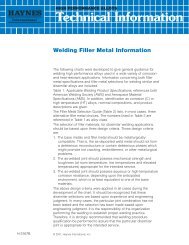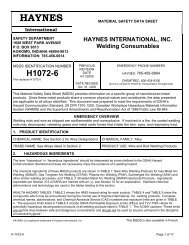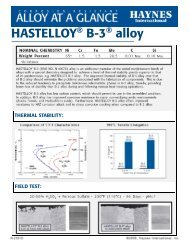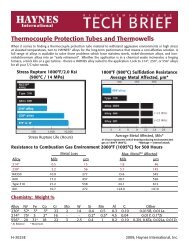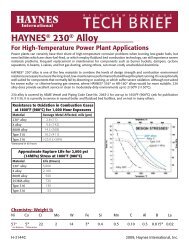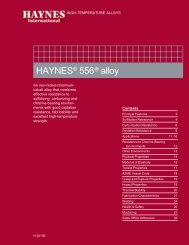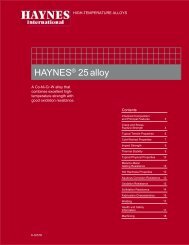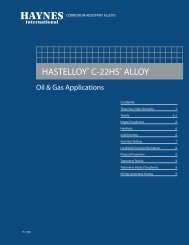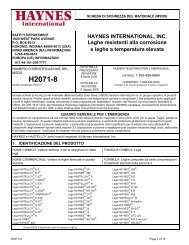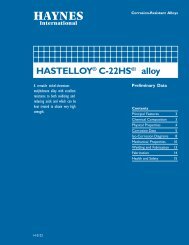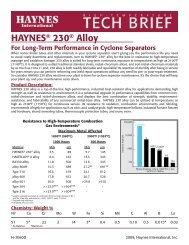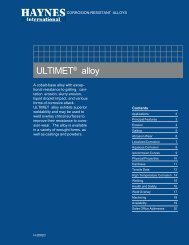CORROSION RESISTANCE OF HASTEllOY®AllOYS - Haynes ...
CORROSION RESISTANCE OF HASTEllOY®AllOYS - Haynes ...
CORROSION RESISTANCE OF HASTEllOY®AllOYS - Haynes ...
You also want an ePaper? Increase the reach of your titles
YUMPU automatically turns print PDFs into web optimized ePapers that Google loves.
ALLOY CHARACTERISTICS<br />
HASTELLOY® alloy B-2 is a nickel-base wrought<br />
alloy with excellent resistance to hydrochloric acid<br />
at all concentrations and temperatures. It also<br />
withstands hydrogen chloride, sulfuric, acetic and<br />
phosphoric acids. The alloy has excellent resistance<br />
to pitting, to stress-corrosion cracking and to knifeline<br />
and heat-affected zone attack. It resists the<br />
formation of grain-boundary carbide precipitates ir<br />
the weld heat-affected zone, thus making it suitable<br />
for most chemical process applications in the aswelded<br />
condition.<br />
Ask for Bulletin H-2006<br />
HASTELLOY® alloy C-22 - a versatile nickelchromium-molybdenum<br />
alloy with better overall<br />
corrosion resistance than other Ni-Cr-Mo alloys<br />
available today, including HASTELLOY alloy C-276<br />
and C-4 and CABOT alloy No. 625. Alloy C-22 has<br />
outstanding resistance to pitting, crevice corrosion<br />
and stress-corrosion cracking. It has excellent<br />
resistance to oxidizing aqueous media including<br />
acids with oxidizing agents, wet chlorine and<br />
mixtures containing nitric acids or oxidizing acids<br />
with chloride ions. HASTELLOY alloy C-22 has<br />
outstanding resistance to both reducing and<br />
oxidizing media and because of its versatility can be<br />
used where "upset" conditions are likely to occur or<br />
in multipurpose plants.<br />
Alloy C-22 also has exceptional resistance to a<br />
wide variety of chemical process environments,<br />
including strong oxidizers such as ferric and cupric<br />
chlorides, hot contaminated media (organic and<br />
inorganic), chlorine, formic and acetic acids, acetic<br />
anhydride, and seawater and brine solutions.<br />
Ask for Bulletin H-2019<br />
HASTELLOY® alloy C-276 has excellent resistance<br />
to pitting, stress-corrosion cracking, and oxidizing<br />
atmospheres up to 1900 deg. F (1038 deg. C). It has<br />
exceptional resistance to a wide variety of chemical<br />
process environments, including strong oxidizers<br />
such as ferric and cupric chlorides, hot<br />
contaminated media (organic and inorganic),<br />
chlorine, formic and acetic acids, acetic anhydride,<br />
and seawater and brine solutions. It resists the<br />
formation of grain-boundary precipitates in the weld<br />
heat-affected zone. Therefore, it too is suitable for<br />
most chemical process applications in the aswelded<br />
condition.<br />
Ask for Bulletin H-2002<br />
Alloy G-3 has excellent resistance to mixed acids,<br />
sulfate compounds, contaminated nitric acid, wet<br />
flue-gas desulfurization scrubber environments and<br />
hydrofluoric acid. The alloy's resistance to the<br />
formation of grain-boundary precipitates in the<br />
heat-affected zone makes it suitable for use in most<br />
chemical process applications in the as-welded<br />
condition.<br />
Ask for Bulletin H-2009<br />
HASTELLOY® alloy G-30 - a high chromium nickelbase<br />
alloy shows superior corrosion resistance ov~r<br />
most other nickel- and iron-base alloys In<br />
commercial phosphoric acid and many complex<br />
environments containing highly oxidizing agents<br />
such as nitric acid.<br />
Ask for Bulletin H-2028<br />
HASTELLOY® alloy X is a nickel-chromium-ironmolybdenum<br />
alloy which has wide use in gas turbine<br />
engines for combustion zone components because of<br />
its exceptional combination of oxidation resistance,<br />
fabricability and high-temperature strength. It is also<br />
used in the chemical process industry for retorts,<br />
muffles, catalyst support grids, furnace baffles, tubing<br />
for pyrolysis operations and flash drier components.<br />
Ask for Bulletin H-3009<br />
HAYNES® alloy No. 25 is a cobalt-base alloy which<br />
combines good formability, wear and corrosion<br />
resistance with excellent high-temperature properties<br />
to 1900 deg. F (1038 deg. C). Alloy No. 25 is generally<br />
stronger than alloy X but is not quite as oxidation<br />
resistant.<br />
Ask for Bulletin F-30,041<br />
CABOT~ alloy No. 625 is a nickel-chromiummolybdenum<br />
alloy with excellent corrosion<br />
resistance, high strength and oxidation resistance. It is<br />
resistant to a wide variety of corrosive media including<br />
phosphoric acid, organic acids, seawater and<br />
pollution control environments. Alloy No. 625 also<br />
resists stress-corrosion cracking, pitting and<br />
intergranular attack. It has high strength up to<br />
approximately 1800 deg. F (980 deg. C) coupled with<br />
good resistance to oxidizing atmospheres.<br />
Ask for Bulletin H-1019<br />
HASTELLOY® alloy G-3 is an improved wrought<br />
version of HASTELLOY alloy G. Alloy G-3 has the<br />
same excellent general corrosion resistance as alloy<br />
G, along with greater resistance to heat-affected<br />
zone attack and excellent weldability. It has<br />
outstanding resistance to hot sulfuric and<br />
phosphoric acids, and withstands the corrosive<br />
effects of both oxidizing and reducing agents and<br />
can handle both acid and alkaline solutions.<br />
4<br />
MULTIMET® alloy is an iron-base alloy for use in<br />
applications involving high stresses at temperatures<br />
up to 1500 deg. F (816 deg. C), and moderate stresses<br />
at up to 2000 deg. F (1093 deg. C). It has good<br />
oxidation resistance, ductility and is readily fabricated.<br />
Its high-temperature properties are inherent and are<br />
not dependent upon age hardening.<br />
Ask for Bulletin H-3010




